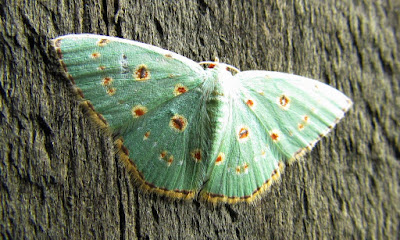Found two more moths that I have not seen before that I have been able to identify and others that I have not so I am restricting this post to the know species.
The first was attracted by the light through the window and fluttered up and down before settling to allow a photo.
It is the Pink Bellied Moth or Hakea Wine Moth Oenochroma vinaria and the caterpillars feed on grevilleas, hakeas and banksias.
The next morning I found this very pretty emerald flat out against the ceiling on the verandah giving me an excellent opportunity for a photo.
Another of the many Geometroidea family this species is Eucyclodes syn Anisozga pieroides the Wattle Bizarre Looper whose caterpillars feed on acacia species, roses, macadamias, and Syzygium leuhmannii .
Thursday 31 March 2016
Wednesday 30 March 2016
Procession off track
At present we have a lot of Processionary Caterpillars moving around in a line, that can be quite long (measure one at 5m with over 100 individuals) from one feeding tree (usually an acacia) to another but we found one procession off track heading into the garage.
There was also a little bit of confusion when a break in the line caused a build-up to occur with no leader to head them out.
They are the larvae of the Processionary Caterpillar Moth Orhrogaster lunifer (photos from an earlier post below)
There was also a little bit of confusion when a break in the line caused a build-up to occur with no leader to head them out.
They are the larvae of the Processionary Caterpillar Moth Orhrogaster lunifer (photos from an earlier post below)
Tuesday 22 March 2016
Orange spotted emerald
Found a quite tiny emerald Geometridae moth on the verandah post and from a distance it looked a plain bright green as so many of this family do, but a close look showed some quite beautiful features.
The moth species is Cosmostola laesaria with a wingspanof about 15 mm and can be found in the Northern Territory, Queensland and New South Wales.
The looper caterpillar larvae feed on a wide variety of plants including mango and melaleuca.
The moth species is Cosmostola laesaria with a wingspanof about 15 mm and can be found in the Northern Territory, Queensland and New South Wales.
The looper caterpillar larvae feed on a wide variety of plants including mango and melaleuca.
Wednesday 9 March 2016
Mud construction
Around the house some of the most evident insect activity is the presence of mud wasp nests, as the wasps take advantage of shelter from the weather that is provided under eaves, around windows, doors and any convenient niche.
Most nests are small but one wasp, the Large Mud-nesting Wasp Abispa splendida, builds quite large constructions to store the caterpillars on which their eggs are laid, as the ready food supply for the larva.
The nests contain a number of individual cells and once the new wasps have emerged from their pupa they excavate their way out of the nest. This must be quite a feat as the nest is like concrete. The body of the wasp is about 25mm and the size of the nest is most often about 150mm in length, 75mm wide and 50mm thick.
This nest is one of two that are being competed at the moment by two pair of these wasps. On the top right of the photo below there are two old mud nests made by one of the smaller species of mud wasps.
Monday 7 March 2016
Jewel netted
Scooping leaves out of the pool and noticed a fluttering on the surface, so netted the critter and saw a brilliant flash of iridescent blue.
A small butterfly but its wings did not seem to be fully formed, leading me to think that it had just emerged from its pupa and been blown into the pool by the afternoon's very gusty wind.
I took some photos with my Iphone and then place the butterfly on a spray of Buddleia flowers then got the camera for some more shots to enable the identification.
Although the wings were not fully extended there was enough detail for me to identify the butterfly as a male Diggle's Jewel or Blue Hypochrysops digglesii. The larvae feed on various mistletoe species, many of which are on our Eucalyptus near the pool area. Pleased to make this rescue and add this butterfly to my list of species found here.
Subscribe to:
Posts (Atom)










